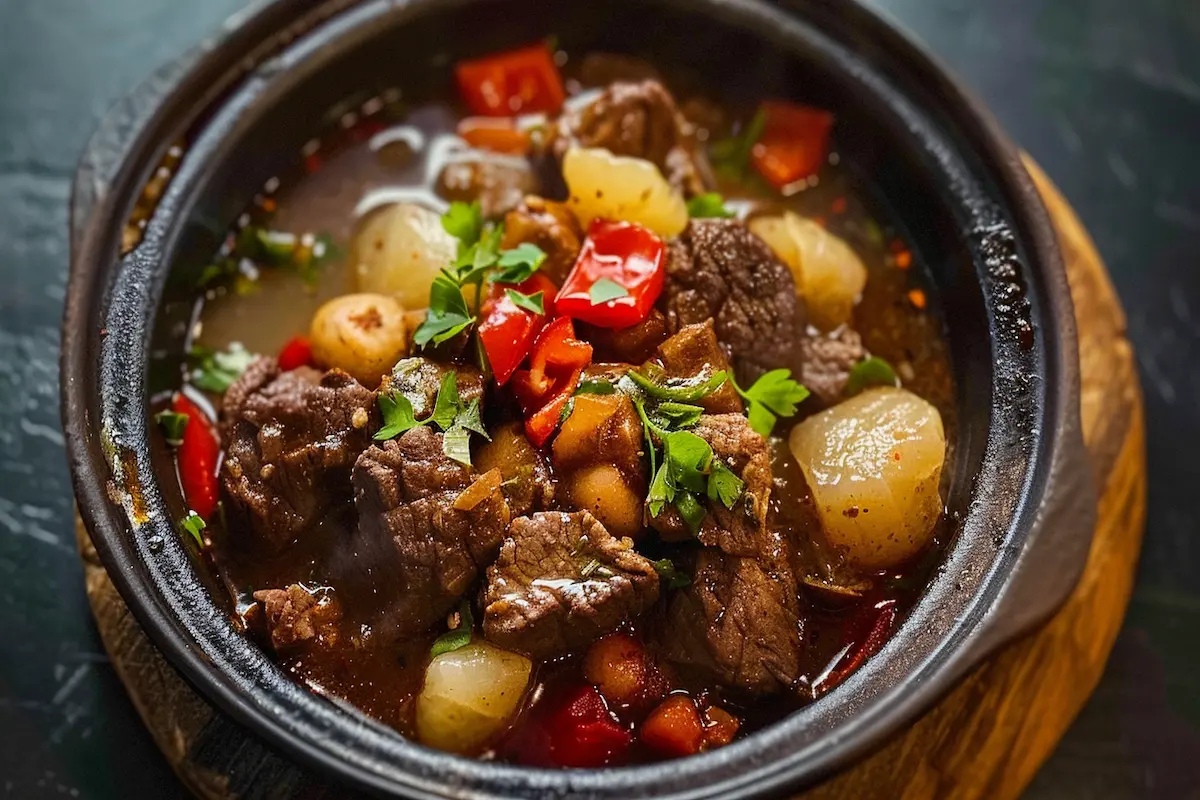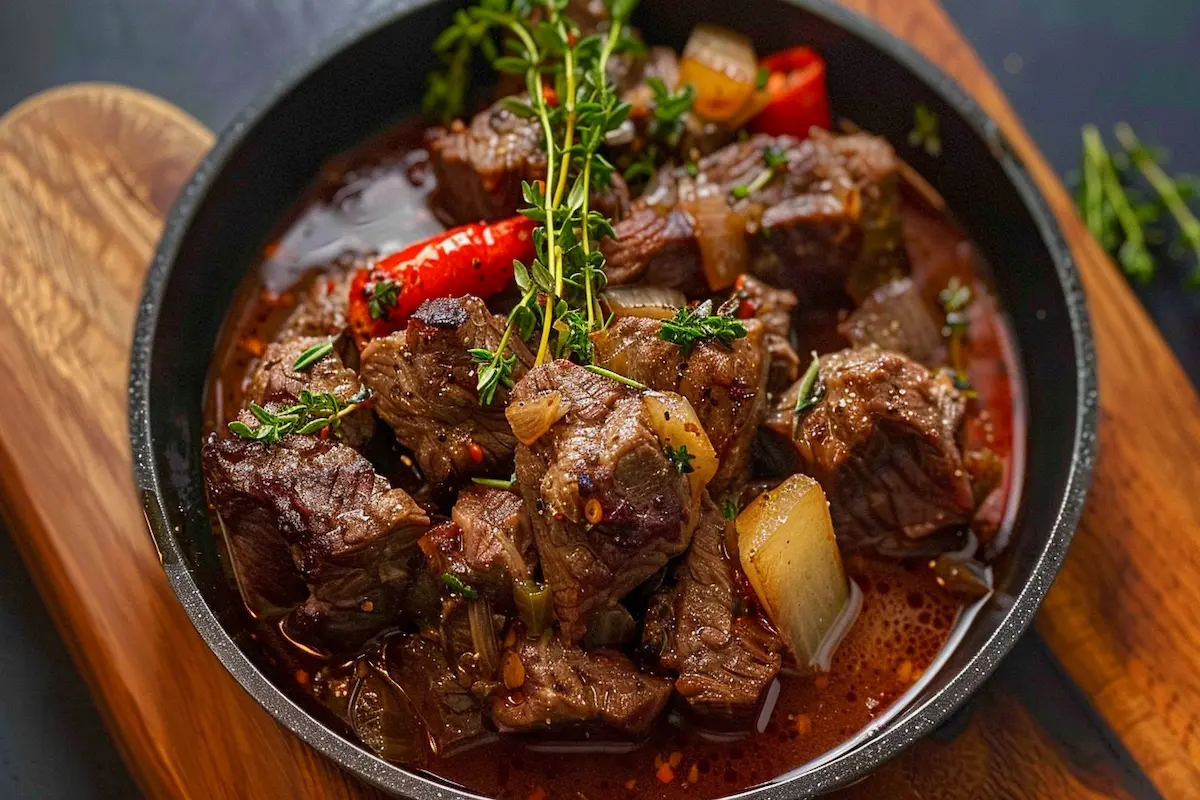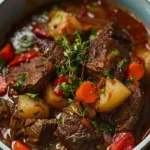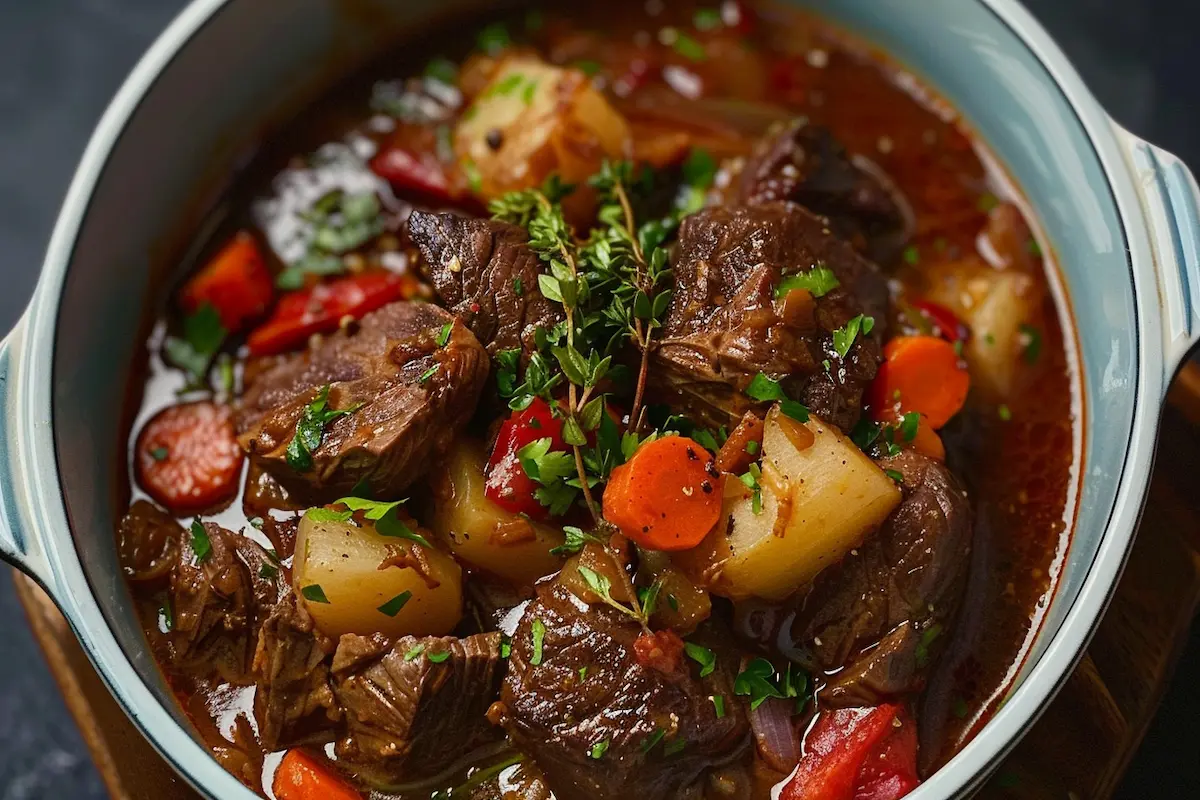Introduction: Beef Stew Seasoning Recipe
Beef stew has been a staple comfort dish for generations, warming homes and filling bellies. It’s a dish that is both simple and complex—simple in its ingredients but complex in its flavors. However, the essence of any good beef stew lies in its seasoning. Without the right balance of spices and herbs, even the finest cuts of beef and freshest vegetables can taste dull. This comprehensive guide will take you through everything you need to know about crafting the perfect beef stew seasoning, ensuring every bite is packed with robust, savory goodness. Along the way, we’ll explore different seasoning methods, ingredient combinations, and internal linking to enrich your experience with related recipes, tips, and tricks from Ollie Recipes.
Why Seasoning Matters in Beef Stew
Before diving into recipes and techniques, it’s important to understand why seasoning plays such a pivotal role in making beef stew a flavorful dish. Seasoning doesn’t just add flavor—it also enhances the natural taste of the beef and vegetables, helps to tenderize the meat, and builds layers of complexity that make each spoonful better than the last.
A well-seasoned beef stew strikes a balance between savory, sweet, spicy, and herbal notes. By using a variety of seasonings, you can create a depth of flavor that makes your beef stew truly stand out. The seasoning you choose should complement the natural flavors of your beef while introducing new dimensions that elevate the dish.
Explore how balancing flavors can transform your cooking by reading our Ultimate Guide to Spicy Rigatoni Recipe, where we discuss how to balance heat and creaminess for a perfect dish.

Essential Seasonings for Beef Stew
A good beef stew seasoning mix typically contains a combination of salt, pepper, herbs, and spices. Below, we outline the essential seasonings that will give your beef stew the bold, rich flavor you crave.
1. Salt
Salt is the foundation of flavor in any dish. It enhances the natural taste of the beef and helps to bring out the sweetness of the vegetables. But remember, it’s important to use salt sparingly at first. You can always add more later, but you can’t take it out once it’s been added.
2. Black Pepper
Black pepper adds a subtle, earthy spice to beef stew. Freshly ground black pepper works best, as it retains more of its natural oils and flavor. Don’t be afraid to add a little extra if you like a bit of heat in your stew.
3. Garlic Powder
Garlic powder is a quick and easy way to infuse your beef stew with an earthy, slightly spicy flavor. If you prefer fresh garlic, by all means, use that—just be aware that it can be a little more potent, so adjust your quantities accordingly.
4. Onion Powder
Onion powder provides a sweet, savory note that deepens the flavor of the stew without overpowering it. Like garlic powder, it’s a convenient alternative to fresh onions, which can sometimes become mushy when cooked for long periods.
5. Thyme
Thyme is a classic herb used in beef stew recipes, offering a subtle minty flavor that complements the beef without overpowering it. If you can get your hands on fresh thyme, it will make a noticeable difference.
6. Rosemary
Rosemary brings a slightly piney aroma to your beef stew, enhancing the rich flavors of the beef. It’s another herb that works best when fresh but can still be effective in its dried form.
7. Bay Leaves
Bay leaves add a floral, slightly spicy aroma that helps tie the whole dish together. Don’t forget to remove them before serving!
8. Paprika
Paprika adds a sweet, smoky note to your beef stew. Opt for smoked paprika if you want to introduce an extra layer of complexity and warmth to your stew.
9. Cumin
Cumin is an optional but excellent addition to beef stew seasoning. It provides a warm, nutty flavor that pairs beautifully with the beef and vegetables.
10. Chili Flakes
For those who like their stew with a bit of heat, chili flakes are a must. Start small and add more as needed to suit your taste.
If you’re looking for more ideas on how to balance these flavors, consider checking out our Comprehensive Guide to Baked Beans, where we explore how seasonings can completely transform a simple dish into something spectacular.
How to Make Your Own Beef Stew Seasoning Recipe Mix
Now that we’ve covered the essential ingredients, let’s move on to creating your very own beef stew seasoning mix. This mix can be stored in an airtight container and used whenever you’re in the mood for a rich, hearty stew.
Homemade Beef Stew Seasoning Recipe
- 1 tablespoon salt
- 1 tablespoon black pepper
- 1 tablespoon garlic powder
- 1 tablespoon onion powder
- 1 tablespoon dried thyme
- 1 tablespoon dried rosemary
- 2 bay leaves
- 1 teaspoon smoked paprika
- ½ teaspoon cumin
- ½ teaspoon chili flakes (optional)
Mix all the ingredients in a small bowl and store them in an airtight container. This blend can be used in other dishes, too, like roasted vegetables or even grilled meats. Feel free to experiment with the quantities to suit your own tastes.
If you’re interested in more seasoning blends, we recommend our Ultimate Guide to Rotisserie Chicken Recipes, which covers a variety of ways to enhance chicken using different spice mixes.
Cooking Techniques for Maximum Flavor
Seasoning alone isn’t enough to make a great beef stew—you also need to use the right cooking techniques to ensure that the flavors develop properly. Let’s explore some techniques that will make your beef stew truly unforgettable.
Searing the Beef
One of the most important steps in making a flavorful beef stew is searing the beef. By browning the beef on high heat before adding it to the pot, you’re locking in the juices and creating a caramelized crust that will enhance the overall flavor of the stew. Make sure to use a heavy-bottomed pan and avoid overcrowding it, as this can prevent the beef from browning properly.
Deglazing the Pot
After searing the beef, don’t forget to deglaze the pot! This process involves adding a liquid—like red wine or beef broth—to the hot pan to loosen the flavorful bits stuck to the bottom. These bits add a ton of flavor to the stew and help create a rich, robust broth.
Deglazing is a key technique not only in beef stew but also in other slow-cooked dishes like the ones featured in our Ultimate Beef Stir Fry Recipe, which benefits from the same method to enhance the sauce.
Slow Cooking for Tender Meat
Beef stew is best when it’s cooked low and slow, whether in a slow cooker, Dutch oven, or even on the stovetop. Slow cooking allows the flavors to meld together and tenderizes the beef until it’s melt-in-your-mouth tender. Depending on your cooking method, beef stew can take anywhere from 2 to 6 hours to reach perfection, but the wait is well worth it.
Explore more slow-cooking techniques in our Ultimate Guide to Chicken Brine, where we explain how brining and slow cooking can make chicken dishes incredibly juicy and flavorful.

Variations in Beef Stew Seasoning Recipe: Regional and Cultural Twists
While the classic beef stew is delicious, sometimes it’s fun to experiment with regional or cultural twists. Depending on the country or culture, beef stew seasoning can vary greatly, offering new and exciting flavors.
French Boeuf Bourguignon
The French version of beef stew, known as Boeuf Bourguignon, uses red wine as the main cooking liquid and often includes ingredients like pearl onions, bacon, and mushrooms. The seasoning mix is slightly more refined, with a focus on thyme, bay leaves, and garlic. For a more authentic touch, use a good Burgundy wine for braising.
You can read more about classic French dishes and the techniques behind them in our Guide to Baking the Perfect Pineapple Upside Down Cake, where attention to detail in both ingredients and methods is key.
Irish Beef Stew
Irish beef stew typically includes potatoes, carrots, and parsnips, and it’s often cooked with Guinness or another dark stout. This gives the stew a deep, rich flavor that is balanced by herbs like thyme, parsley, and bay leaves.
Mexican-Inspired Beef Stew
For a Mexican twist on beef stew, try adding cumin, coriander, and chipotle peppers to your seasoning mix. These spices will give the stew a smoky, slightly spicy flavor that pairs well with corn, black beans, and diced tomatoes. Serve it with rice or tortillas for a complete meal.
Asian Beef Stew
Asian versions of beef stew often include ingredients like soy sauce, ginger, and star anise. The combination of these seasonings creates a rich, savory broth with a slightly sweet undertone. This type of stew is best served with rice or noodles.
To explore more fusion cuisine, check out our Guide to Philly Cheesesteak Meatloaf, where we combine classic American flavors with new twists to create something entirely unique.
How to Serve and Pair Beef Stew
Once your beef stew is ready, it’s time to think about how to serve it. While beef stew is hearty enough to be a meal on its own, you can elevate the dining experience by pairing it with the right sides.
Crusty Bread
There’s nothing quite like tearing into a piece of crusty, fresh-baked bread to soak up the rich broth of a beef stew. You can try making your own bread at home or serve store-bought, but either way, make sure it’s fresh!
Mashed Potatoes
For a comforting and classic side, serve your beef stew over a bed of mashed potatoes. The creamy texture of the potatoes contrasts nicely with the rich, hearty stew.
Steamed Vegetables
Add a bit of color and nutrition to your plate by serving steamed green beans, broccoli, or carrots alongside your stew. The vibrant vegetables offer a nice contrast to the heavy stew, and they’re great for soaking up extra broth.
Explore how to pair various dishes with your stew in our article on Easy Homemade Beef Brisket Chili, where we cover different serving suggestions for chili, another comfort food classic.
Tips for Storing and Reheating Beef Stew
Beef stew is one of those dishes that gets better with time, as the flavors continue to meld together. Here’s how to store and reheat your stew to enjoy it later.
Refrigerating Beef Stew
If you plan to eat your stew within the next few days, store it in an airtight container in the refrigerator for up to five days. When reheating, add a bit of water or beef broth to the pot to prevent the stew from drying out.
Freezing Beef Stew
For longer storage, beef stew can be frozen for up to three months. It’s best to freeze the stew in individual portions, so you can thaw just what you need. To reheat, let the stew thaw in the refrigerator overnight, then heat it gently on the stove.
Reheating Tips
When reheating beef stew, it’s important not to rush the process. Heat the stew slowly on the stovetop or in the microwave, adding a bit of broth or water as necessary to maintain the consistency.
Learn more about meal prepping and how to store dishes like beef stew in our article on Lunch Ideas: Delicious, Easy, and Healthy Meals, which offers tips on storing and reheating various types of dishes.

Conclusion: Beef Stew Seasoning Recipe
Creating the perfect Beef Stew Seasoning Recipe isn’t difficult, but it does require a balance of flavors and the right techniques to bring out the best in your ingredients. Whether you’re making a traditional beef stew or trying a new variation like Boeuf Bourguignon or a Mexican-inspired stew, the key to success lies in the seasoning.
By understanding the importance of herbs, spices, and cooking methods like searing and slow cooking, you can take your beef stew to the next level. Don’t be afraid to experiment with different seasoning mixes and regional variations to create a dish that suits your tastes perfectly.
For more inspiration, be sure to check out Ollie Recipes for related dishes like the Ultimate Guide to Rotisserie Chicken Recipes or our Ultimate Beef Stir Fry Recipe. Happy cooking!
Print
Beef Stew Seasoning Recipe for Rich Flavor
- Total Time: 5 minutes
- Yield: About ½ cup seasoning mix 1x
Description
This homemade Beef Stew Seasoning Recipe brings a deep, rich, and hearty flavor to your stew. With a blend of savory herbs and spices, this seasoning mix enhances the natural flavors of beef and vegetables, making your stew a comforting, soul-warming meal. Perfect for slow cooking or simmering on the stovetop, this seasoning is versatile, easy to make, and can be stored for future use.
Ingredients
- 1 tablespoon salt
- 1 tablespoon freshly ground black pepper
- 1 tablespoon garlic powder
- 1 tablespoon onion powder
- 1 tablespoon dried thyme
- 1 tablespoon dried rosemary
- 2 bay leaves
- 1 teaspoon smoked paprika
- ½ teaspoon cumin
- ½ teaspoon chili flakes (optional, for heat)
- ¼ teaspoon nutmeg (optional, for added warmth)
Instructions
- Mix Ingredients: In a small mixing bowl, combine the salt, black pepper, garlic powder, onion powder, thyme, rosemary, bay leaves, paprika, cumin, and chili flakes. Optionally, add nutmeg for a slightly warmer flavor profile.
- Store: Transfer the seasoning mix to an airtight container or jar. Store in a cool, dry place. This mix can last for up to 6 months when stored properly.
- Use in Beef Stew: When making your beef stew, use about 2-3 tablespoons of the seasoning mix per 2 lbs of beef. Add the seasoning while browning the beef or when you’re simmering the stew. Adjust the quantity according to your taste.
- Cooking Tip: After browning the beef, deglaze the pan with red wine or beef broth to capture all the flavorful bits before adding the beef back to the pot.
Notes
- For a spicier stew, increase the amount of chili flakes or add a pinch of cayenne pepper.
- If you prefer a milder stew, reduce the black pepper and omit the chili flakes.
- This seasoning mix also works great with roasted vegetables, grilled meats, or even as a rub for slow-cooked brisket.
- Adjust the salt and pepper levels depending on your personal preference or if you’re using a salted broth.
- Prep Time: 5 minutes
- Cook Time: 0 minutes
- Category: Seasoning, Spice Mix
- Cuisine: American, Comfort Food
Nutrition
- Calories: 6
- Sugar: g
- Sodium: 232mg
- Fat: 0g
- Carbohydrates: 1g
- Fiber: 0.3g
- Protein: 0.2g

